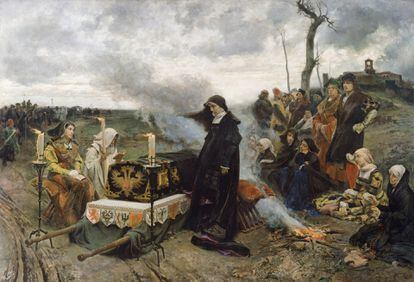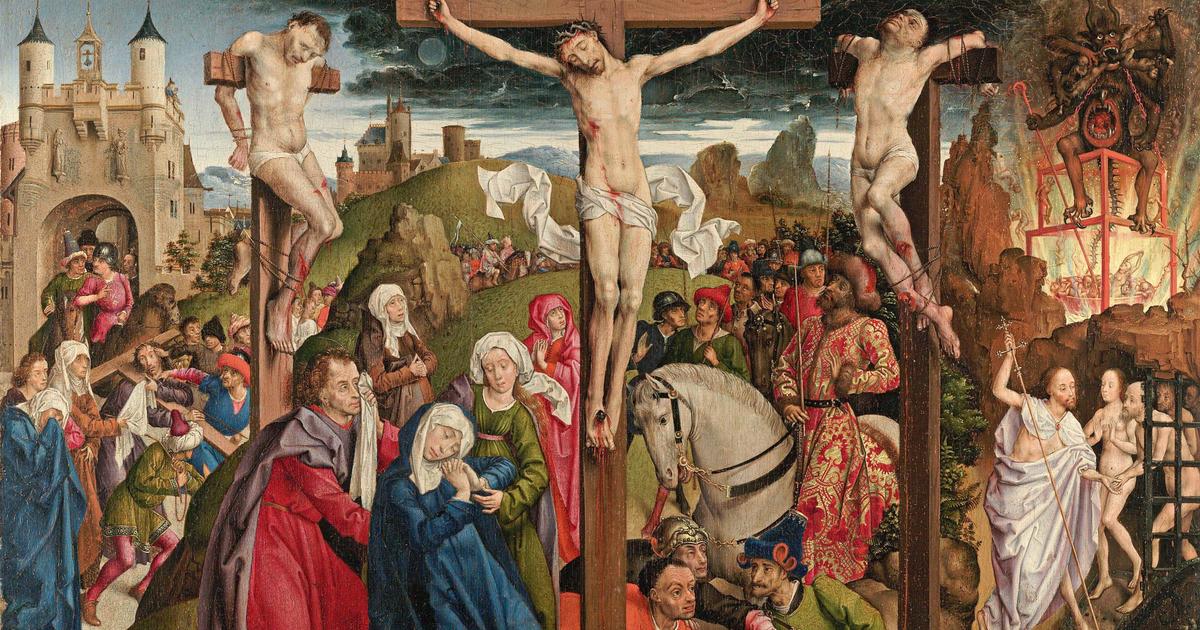"The history of Spain is that of a very contradictory country."
Based on this lapidary phrase, the retired psychiatrist Enrique González Duro (La Guardia, Jaén, 82 years old) develops his thesis on the monumental
Historia de la locura en España
(Siglo XXI publishing house in Spain, 744 pages), in which he describes anomalous behaviors of kings, politicians, artists and anonymous citizens in a journey that starts from the late Middle Ages and reaches the Franco regime.
In that stretch, possessed, witches, pious, enchanted, enlightened ...
The first of these paradoxes, crucial, is that the first asylum known in the West was opened on Spanish soil. It was in Valencia, in 1409, but national psychiatry did not take off until the 19th century and as an imitation of the one that emerged in France after the Revolution of 1789.
"The reason for the difference in how insanity was approached in Spain with other countries is the Inquisition brand," explains González Duro at his home in Madrid.
“It was an ideological police that impeded scientific investigation.
It depended on political power, not like in other States, where it did from Rome.
The beginning of the treatment of insanity, then a social problem because it was a marginal minority in the streets, is probably due to the Mercedarian friars, who were the ones who paid for the ransom of Christian prisoners of Muslims in North Africa ”.
Dr. González Duro makes a point to remember that the word crazy comes from Arabic.
Enrique González Duro, with a copy of "History of madness in Spain", at his home in Madrid on December 21. Santi Burgos
“These friars saw what was done in those places with the insane and brought that modern idea, which was not in Europe, that they had to be locked up and put doctors to treat them. In Spain, it was Valencian merchants, a very important Mediterranean sea port, who paid for this first center so that those who had lost their minds would not cause problems for their businesses, as they were a potential danger ”. Not in vain, Lope de Vega set two centuries later his famous work
Los locos de Valencia
at the mental hospital in that city.
This was followed by those from Seville, Toledo, Valladolid ... But another distinction in the Spanish case, he explains, was that no doctors were actually put in those centers, "and the few that there were had no power."
"The asylums became atrocious prison institutions."
González Duro, author of
Sexual repression, social domination
(1976), on the morality of western Christian society, or
Biography of fear
(2007), on our fears in today's world, adds: “In the Middle Ages, crazy, poor and lepers were mixed, they were treated in the same way, locking them up, they were not even classified as sick, and the best doctors were dedicated to the noble classes and the kings ”.
Precisely, the behavior of several Spanish monarchs is analyzed in the book.
Perhaps the most popular case is that of Queen Juana I of Castile, who has gone down in history as “La Loca”.
He describes her as a very jealous woman in the face of the affairs of her husband, Felipe el Hermoso, although she remembers that political intrigues motivated him and Juana's father, Fernando el Catolico, "to conch themselves to be considered incapacitated, until the To the point that the Courts of Valladolid had to examine it, but decided not to disable it.
In this process she says: 'My mother [Isabel la Católica] had a worse temper than me and no one called her crazy ”.
Oil painting 'Doña Juana la Loca' (1877), by Francisco Pradilla. PRADO MUSEUM
The death of El Hermoso, in 1506, destroys her, but the psychiatrist points out that it is one of the examples "of how the history of Spain has been falsified." “It was said that she followed her husband's tomb to Granada, but it was for a testamentary issue. It also became a symptom of his madness that the coffin was opened every so often, but it was for a matter of hygiene, in case he had worms and to see how the corpse was. Or that the funeral procession lengthened, but it stopped because it passed through areas where there was plague.
The truth is that Juana abandons herself: she does not wash, she does not change her clothes, she eats without cutlery, she sleeps on the floor ... “Her father locks her up in the castle of Tordesillas, with a cruelty that has hardly been seen. She is in solitary confinement, in a windowless room, poorly fed, the servants were vigilant… This was hardened by her own son, the future Emperor Charles V ”, after the revolt of the comuneros, who wanted her as sovereign. The situation lasted 46 years, until his death in 1555. “It is clear that she ended up crazy. There is no one who can resist such a regime. At the end of his life he rebelled, he blasphemed, he did not go to mass ... ”.
Of Felipe II he emphasizes that "neither his life nor his death were normal." “He had the obsessive mania of writing everything about government affairs, he was very cold, distrustful; and his death was preceded by a long and frightening agony, in which all kinds of relics were brought to him ”. To this he adds "the episode of the death of his son, who has wanted to whitewash." Don Carlos was "an angry child, cruel to animals, mistreated the servants." "Crazy and furious," the French ambassador described it. The so-called prudent king “ordered him to be locked up in the castle of Arévalo for treason, due to his conversations with the independentists of the Netherlands; he even wrote to other kings justifying the measure ”. At six months, the Prince of Asturias, who wandered naked and ate objects, was found dead.González Duro points out in the book that his father's inattention hastened his death at the age of 23.
Oil painting 'The crazy house', by Goya (1808-12) .REAL ACADEMY OF FINE ARTS OF SAN FERNANDO
The case of Carlos II, the Bewitched, "was due to inbreeding [his parents were uncle and niece], he was someone that today we would classify as disabled."
The author recounts the attempts to unenchant him, some even at a distance from the Madrid court, and recovers the testimony of the Pope's nuncio when he visited the king when he was 18 years old: “Look with a melancholy and astonished expression.
[...] He is listless, apathetic and irascible, clumsy and indolent and seems stunned ”.
His successor, the first Bourbon, Felipe V, also deserves a comment: “Obsessed with sex and religion”, “with depressive and schizoid features”, he came to wear the same clothes for almost a year, he shunned the sun because he said that he it pierced its back and suffered seizures in which it erupted into hideous screams.
The king called El Animoso, who spent hours and hours in bed with the two wives he had - it even seems that he used aphrodisiacs for his unleashed sexual appetite - abdicated in 1724, but the heir [Louis I, who reigned 229 days] died and they reinstated him on the throne, "when he was clearly incapacitated."
A french revolution
The reign of Carlos IV coincides with the French Revolution, "which is when scientific psychiatry, the medical specialty to treat madmen, was created." “In France they wonder what to do with those who have not killed anyone or committed crimes, but they are rare, they do not comply with the rules. The solution is to create madhouses and put doctors on them. That is when they begin to be considered sick. In Spain a pale and late copy of this model was made already in the 19th century, just as ideas from Germany were timidly imported ”.
The outline of a modern psychiatry in Spain came with the Second Republic, favored by a 1931 decree and the inspection of psychiatric hospitals. “The embryo in Spanish of psychoanalysis arises in Madrid from a group formed in Germany, but with the Civil War, that immense collective madness, they die or are purified or go into exile, especially to Argentina, and that is why a major psychoanalytic movement. Freud was banned here until 1948. Franco was opposed because it touched on the issue of sex. " What did not change in decades was the sordid situation of the madhouses. "Spanish psychiatry, the state's response to insanity, has always been a frustration."
On that regime González Duro has published
The Reds Were Not Crazy
(2008) and
The Rapadas.
The Franco regime against women
(2012).
On how the dictator's mind was, he states: "Franco was a misogynist, self-conscious because his classmates laughed at him for his voice and his mediocre stature, he hated his father and was obsessed with power."
This psychiatrist concludes that madness "has always existed and is everywhere, not only in asylums."
It was already suggested, with a lot of humor, by Woody Allen in the ending of
Annie Hall
:
-Doctor, my brother is crazy.
A hen is believed.
"And why don't you put him in a madhouse?"
-I would, but I need the eggs.
From just over 2,000 admitted to asylums in 1859 to 20,000 in 1910
In the mid-nineteenth century, the Ministry of the Interior published the first official statistics in Spain on the number of insane: 7,277, of which only a little over a thousand were admitted.
A decade later, in 1859, there were 17 public establishments "dedicated entirely or partially to the treatment of the alienated", but weighed down by the few means provided by the State.
There were 2,217 inmates.
In 1879 there were 26 establishments, with 3,790 mentally ill.
This motivated, at the end of the century, the expansion of private asylums.
In 1910, the 35 public psychiatrists already added almost 20,000 admitted.



/cloudfront-eu-central-1.images.arcpublishing.com/prisa/UYLPTY4TSGK24P5UXIFTOYDPNI.jpg)

/cloudfront-eu-central-1.images.arcpublishing.com/prisa/T5Z4IKWRWVEDFFTNEXAHJXDEJM.JPG)



